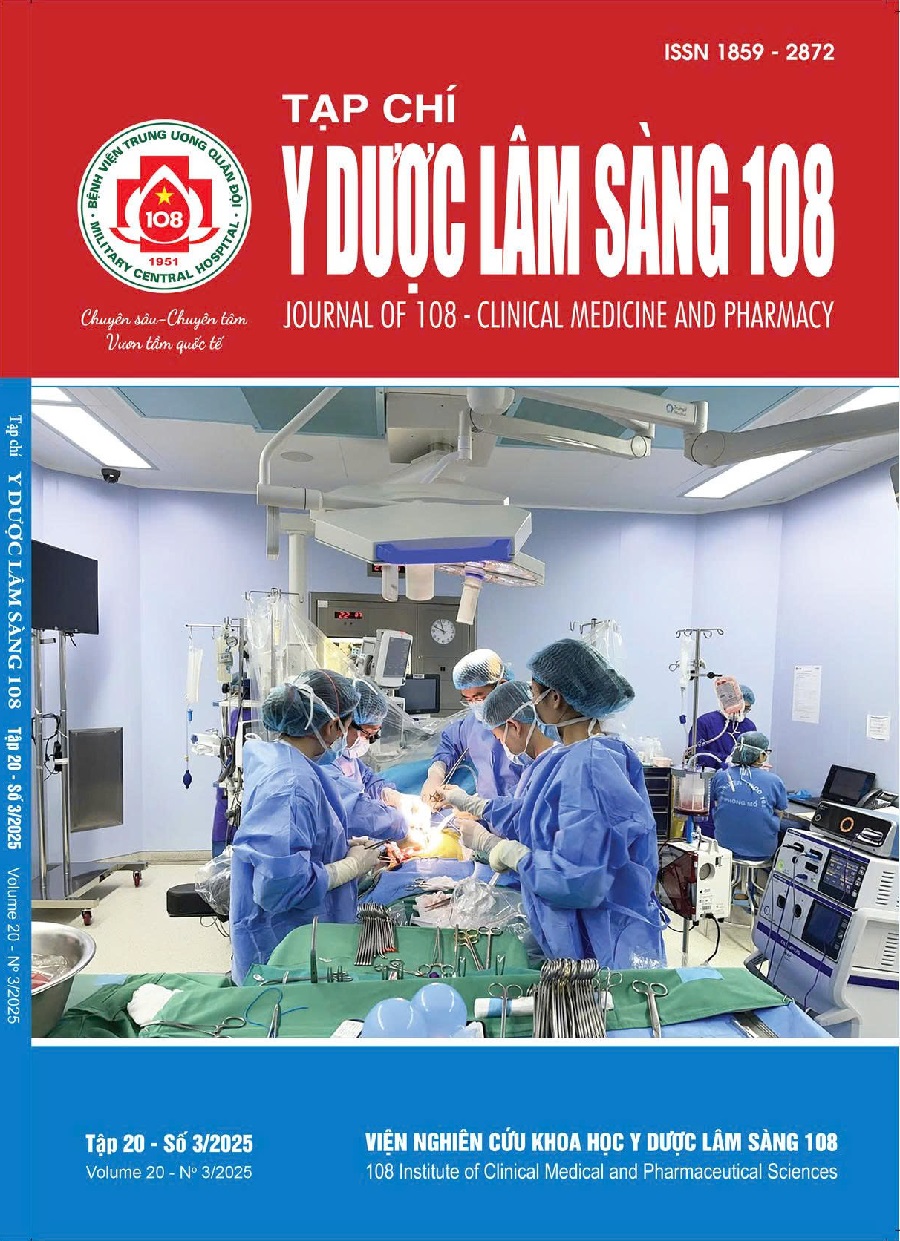Kết quả và tính an toàn của thuốc sinh học trong điều trị bệnh viêm ruột mạn tính tại Bệnh viện Trung ương Quân đội 108
Main Article Content
Keywords
Tóm tắt
Mục tiêu: Nhóm các thuốc sinh học được đánh giá hiệu quả và an toàn với bệnh viêm ruột mạn mức độ vừa và nặng. Tuy nhiên các dữ liệu lâm sàng tại Việt Nam còn rất hạn chế. Do vậy nghiên cứu này nhằm khảo sát độ an toàn và kết quả đáp ứng của các bệnh nhân viêm ruột mạn với 3 thuốc sinh học có tại Việt Nam (Ifliximab, adalimumab, ustekinumab). Đối tượng và phương pháp: Nghiên cứu hồi cứu thu thập dữ liệu của 91 bệnh nhân viêm ruột mạn được điều trị thuốc sinh học tại Khoa điều trị Bệnh ống tiêu hóa, Bệnh viện TƯQĐ 108 từ tháng 1 năm 2020 đến tháng 8 năm 2024. Đánh giá các tiêu chí đáp ứng lâm sàng, thuyên giảm lâm sàng và thuyên giảm nội soi của các bệnh nhân tại các thời điểm 2 tuần, 14 tuần, 6 tháng, 12 tháng, 18 tháng, 24 tháng, 36 tháng và 45 tháng. Đánh giá dung nạp và các tác dụng không mong muốn của các thuốc sinh học. Kết quả: Trong 91 bệnh nhân nghiên cứu: Crohn (71,4%) và 28,6% viêm loét đại trực tràng chảy máu, trong đó nam giới đa số ở cả 2 nhóm. Có 83,5% bệnh nhân dùng infliximab; 7,7% dùng adalimumab và 8,8% dùng ustekinumab. Hầu hết các bệnh nhân đạt thuyên giảm lâm sàng tại 2 tuần và 14 tuần (85-100%); có 94% bệnh nhân duy trì đáp ứng lâm sàng với thuốc infliximab tại 12 tháng. Tại thời điểm 12 tháng điều trị infliximab; có 69% bệnh nhân đạt thuyên giảm lâm sàng và 62,2% đạt thuyên giảm nội soi. Có 5 bệnh nhân gặp phản vệ độ I/II khi truyền infliximab, 4 bệnh nhân lao bùng phát trong quá trình điều trị, 3 bệnh nhân nhiễm khuẩn khác và 1 bệnh nhân nhiễm giun lươn. Chưa ghi nhận ca bội nhiễm nào với 8 bệnh nhân dùng thuốc ustekinumab. Kết luận: Infliximab là thuốc điều trị phổ biến nhất cho các bệnh nhân viêm ruột mạn, có tác dụng cải thiện các triệu chứng lâm sàng nhanh, đạt tỷ lệ cao thuyên giảm lâm sàng và thuyên giảm nội soi. Ustekinumab bước đầu đánh giá hiệu quả tốt và an toàn với nhóm bệnh nhân này.
Article Details
Các tài liệu tham khảo
2. GBD Inflammatory Bowel Disease Collaborators (2020) The global, regional, and national burden of inflammatory bowel disease in 195 countries and territories, 1990-2017: A systematic analysis for the Global Burden of Disease Study 2017. The lancet. Gastroenterology & hepatology 5(1): 17-30.
3. Chen X, Xiang X, Xia W et al (2023) Evolving trends and burden of inflammatory bowel disease in Asia, 1990–2019: A comprehensive analysis based on the global burden of disease study. Journal of Epidemiology and Global Health 13(4): 725-739.
4. Turner D, Ricciuto A, Lewis A et al (2021) STRIDE-II: an update on the Selecting Therapeutic Targets in Inflammatory Bowel Disease (STRIDE) Initiative of the International Organization for the Study of IBD (IOIBD): determining therapeutic goals for treat-to-target strategies in IBD. Gastroenterology 160(5): 1570-1583.
5. Kim DH, Cheon JH (2017) Pathogenesis of Inflammatory Bowel Disease and Recent Advances in Biologic Therapies. Immune Netw 17(1): 25-40.
6. Nakase H, Uchino M, Shinzaki S et al (2021) Evidence-based clinical practice guidelines for inflammatory bowel disease 2020. J Gastroenterol 56: 489–526.
7. Best WR, Becktel JM, Singleton JW, Kern F Jr (1976) Development of a crohn's disease activity index National Cooperative Crohn's Disease Study. Gastroenterology 70: 439-444.
8. Schroeder KW, Tremaine WJ, Ilstrup DM (1987) Oral 5-ASA therapy for ulcerative colitis. New Engl Med 317(26):1625-1629.
9. Dubois-Camacho K, Ottum PA, Franco-Muñoz D et al (2017) Glucocorticosteroid therapy in IBD. World J Gastroenterol 23(36): 6628-6638.
10. Torres J, Caprioli F, Katsanos KH et al (2016) Predicting outcomes to optimize disease management in inflammatory bowel diseases. J Crohns Colitis 10(12):1385-1394.
11. Vallejo-Yagüe E, Keystone EC, Kandhasamy S et al (2021) Primary and secondary non-response: In need of operational definitions in observational studies. Ann Rheum Dis 80: 961-964.
12. Shah SC, Khalili H, Chen CY et al (2019) Sex‐based differences in the incidence of inflammatory bowel diseases pooled analysis of population‐based studies from the Asia‐Pacific region. Aliment Pharmacol Ther 49(7):904-911.
13. Berg DR, Colombel JF, Ungaro R (2019) The Role of Early Biologic Therapy in Inflammatory Bowel Disease. Inflamm Bowel Dis 25(12):1896-1905.
14. Lee YI, Park Y, Park SJ, Kim TI, Kim WH, Cheon JH (2021) Comparison of long-term outcomes of infliximab versus adalimumab treatment in biologic-naïve patients with ulcerative colitis. Gut Liver 15: 232–242. doi: 10.5009/gnl19433.
15. Colombel JF, Sandborn WJ, Reinisch W et al (2010) SONIC Study Group. Infliximab, azathioprine, or combination therapy for Crohn's disease. N Engl J Med 362(15):1383-1395.
16. Banerjee R, Ali RAR, Wei SC, Adsul S (2020) Biologics for the Management of Inflammatory Bowel Disease: A Review in Tuberculosis-Endemic Countries. Gut and Liver 14(6): 685-698.
17. Click B, Regueiro M (2019) A Practical Guide to the Safety and Monitoring of New IBD Therapies. Inflamm Bowel Dis 25(5):831-842.
 ISSN: 1859 - 2872
ISSN: 1859 - 2872
